The observatories above all work with electromagnetic radiation.
 |
Data about other types of radiation require different kinds of observatories: to the left, the concept for eLISA, a gravitational wave observatory based on formation-flying satellites (a mission under study in Europe). Gravity waves will disturb the positions of the satellites slightly, which will be detected by monitoring light beams shining from one satellite to another. (From http://lisa.nasa.gov/mission/index.html) |
The huge range of observatories and methods used in astronomy arises because of the immense range of radiation types we study - a factor of nearly 1020 in the wavelength of electromagnetic radiation, for example, plus gravity waves, energetic protons and other particles called "cosmic rays", fundamental particles like neutrinos, and so forth.
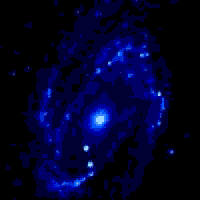 |
Each new wavelength or type of observation seems to teach us
something new about a source.(From G. Bothun, http://zebu.uoregon.edu/movie.html) M81 is a nearby large spiral galaxy. See how its appearance changes as we go from the ultraviolet (blue in this false color image) to the near infrared (red). Here is another example of how the infrared shows us more than the eye can see caution: 30 MB, need high bandwidth! |
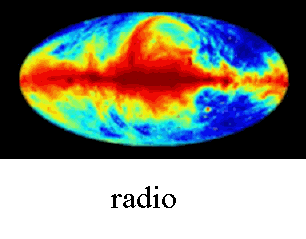 |
In fact, the appearance of the entire sky changes dramatically with
wavelength. To the left is a series of all-sky images. The bright band through the middle
of most of the images is our own Milky Way galaxy. From XMM Newton image
gallery, http://sci.esa.int/home/xmm-newton/index.cfm,
animation by G. RiekeDo you like the effects of false color in these
images |
Telescopes
Most of what we know in astronomy is derived from electromagnetic radiation. At radio through X-ray energies, observatories are built on our ability to bend the path the radiation is following in a controlled way, so it is concentrated at a convenient small area where we detect it.
| For example, when photons are reflected from a surface, they always
exit from the surface at the same relative angle at which they approached it, Here the
angle is shown as the Greek letter theta, |
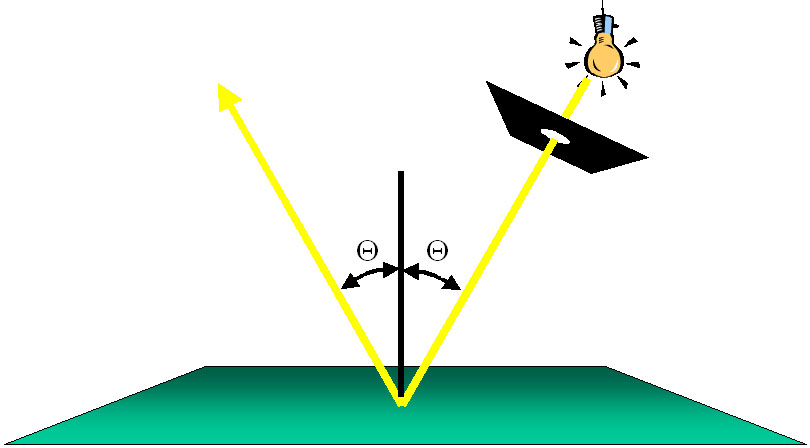 |
| Reflecting telescopes concentrate the light with shaped mirrors, so that no matter where the light strikes the mirror from a distant source, it is directed toward a single spot in space called the focus. The operation of a reflecting telescope is shown to the right. (From http://zebu.uoregon.edu/~js/glossary/reflecting_telescope.html) |
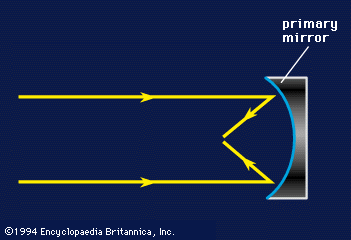 |
| However, it is awkward to have the light from a source be brought to a point that is in the way for the light coming in, so most telescopes use an additional mirror to reflect the light back behind the first mirror to a more convenient position. (from Met_U204, http://www.ii.metu.edu.tr/emkodtu/met204/lectures/section8/page1.html) |
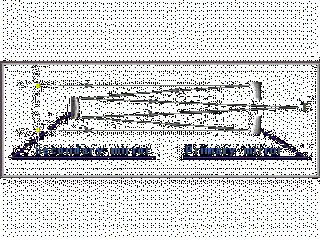 |
In the visible, telescopes can also use refraction in glass. Refraction is based on the slowing of the speed of the light in the glass, which changes its direction at the air/glass interface:
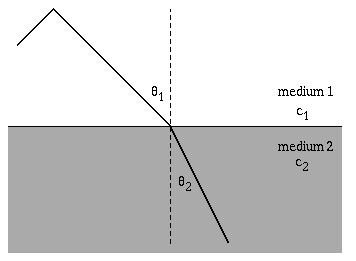 |
The speed of the wave is lower in medium 2 than in medium 1. As it approaches, the side closest to the interface slows down first resulting in an overall change of direction when the whole wave enters medium 2. (From D. A. Russell, http://www.kettering.edu/~drussell/Demos/refract/refract.html) |
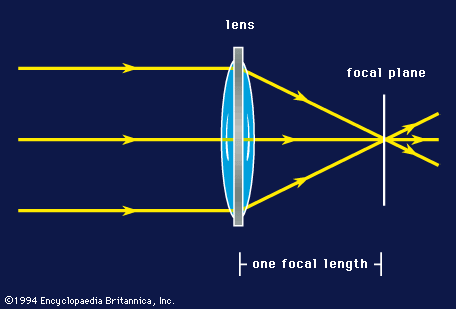 |
By shaping glass appropriately, we can make a
lens that brings the light to a focus in a refracting
telescope. The operation of a refracting telescope is shown to the left (From http://zebu.uoregon.edu/~js/glossary/refracting_telescope.html) |
| Our "Multiple Mirror Telescope" is an example
of a modern reflecting, visible light telescope (the name is a hold-over from the
past; it is generally known by the acronym "MMT.") (from Steward Observatory, http://www.as.arizona.edu/department/Grad%20Files/grad_pro1.html)
|
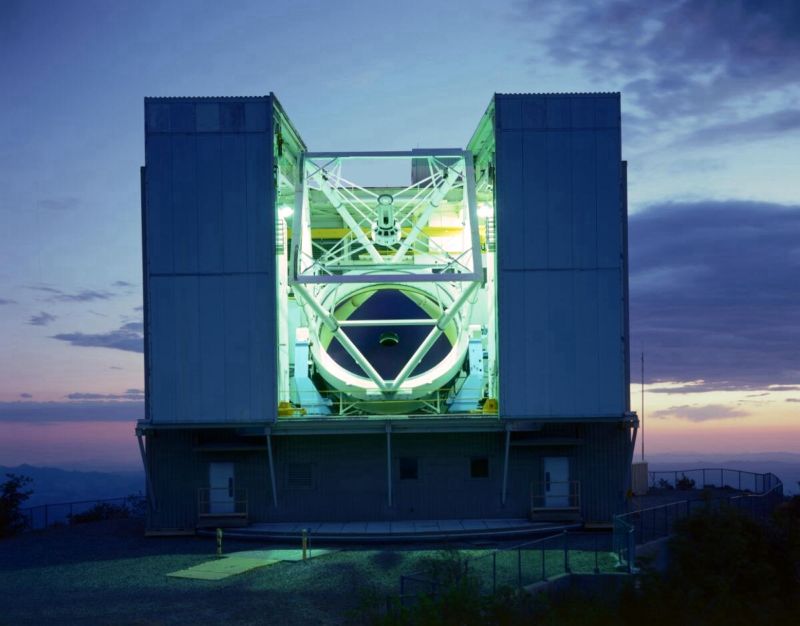 |
| Here is the largest telescope in the world, the Large Binocular Telescope on Mount Graham. Arizona is a 25% partner in the LBT. (photo by Wiphu Rujokaparn and Marc-Andre Bessel) |
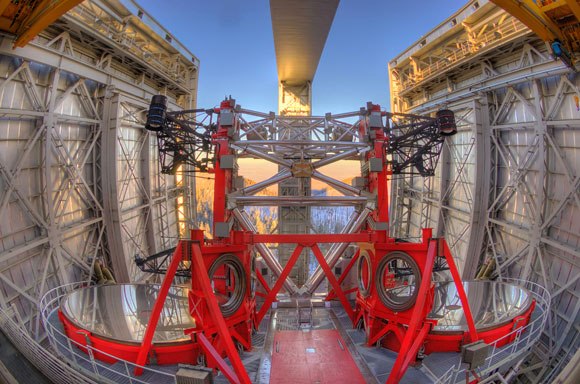 |
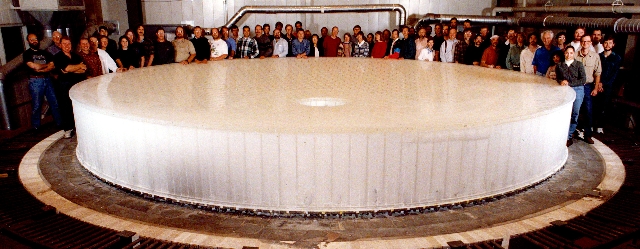
1.) Light Gathering is the amount of signal a telescope delivers. The number of photons we collect increases with the area of the telescope mirror
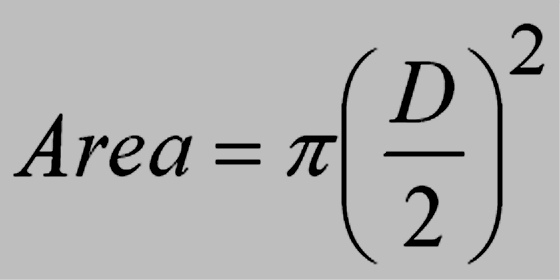
where D is the diameter of the mirror.
Example: A telescope whose diameter is twice as large as another’s will have 4 times the light gathering power.
2.) Resolution
is a measure of the finest detail that we can see![]() The diffraction limit tells us
the theoretical resolution limit set by the behavior of light itself:
The diffraction limit tells us
the theoretical resolution limit set by the behavior of light itself:

where angle is the smallest angle that can be discerned and l is the wavelength of the light and D is the telescope’s diameter. We can write this equation as:

For example, under the best lighting conditions, the pupil of your eye is about 1 to 2mm in diameter, and the wavelength of visible light is 5.5 X 10-4 mm, so the limiting resolution of the eye is 114 to 57 arcseconds, or about 2 to 1 arcminute. Galileo's telescopes were typically limited (by a stop) to a lens diameter of 1 cm = 10 mm, so the limiting resolution was about 11 arcseconds. Here, an arcminute is 60 arcseconds, and a degree is 60 arcminutes. The moon is about half a degree, or 30 arcminutes, or 1800 arcseconds in apparent diameter. We can thank the ancient Babylonians for the factors of 60, which was the base of their number system.
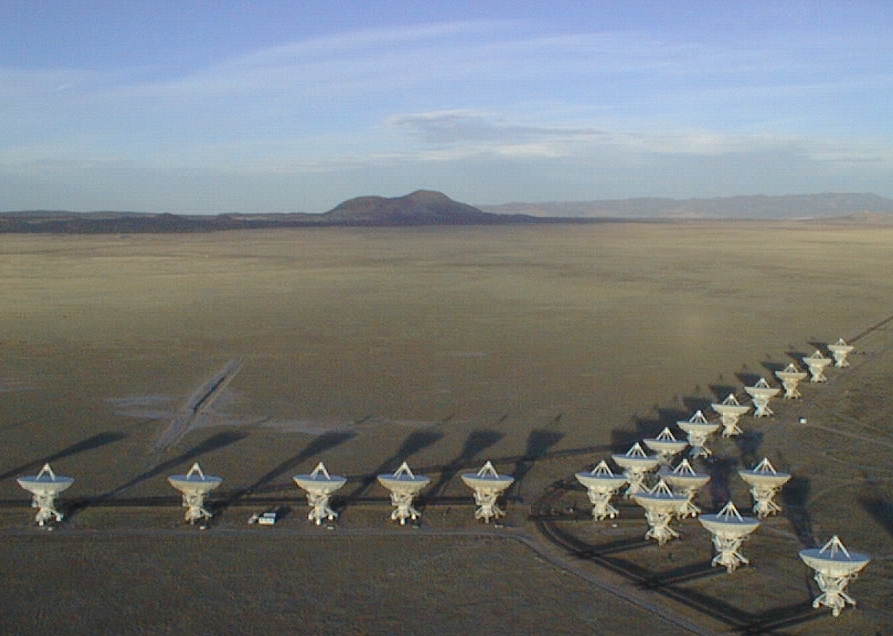 |
In the radio region, we can combine the outputs of many telescopes in a way that we achieve the angular resolution
Thus, we build "interferometers" like the "very large array", or "VLA". The telescopes at smaller spacings fill in parts of the picture that are smoother than the ones only seen with the far-apart ones. Without them, the picture is dominated by the finest details and everything else is missed.(Picture by D. Finley, http://www.aoc.nrao.edu/intro/vlapix/vlaviews.index.html) A new interferometer is just being put into service in Chile, the Atacama Large Millimeter Array (ALMA). |
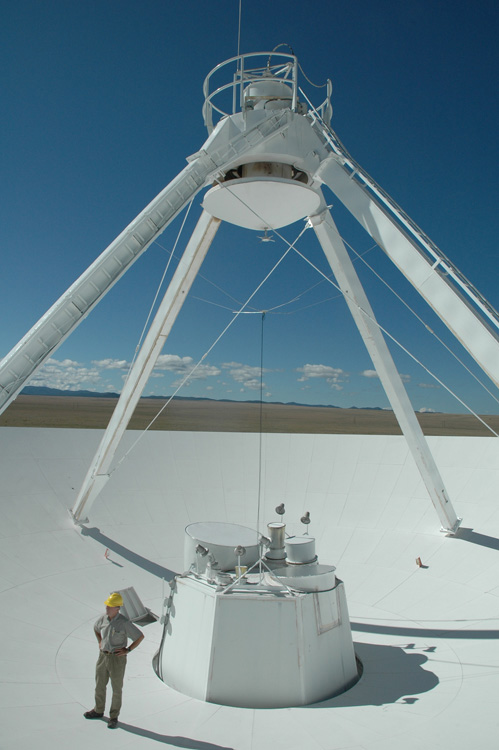 |
This picture of an astronomer in one of the radio telescopes of
the VLA gives a good feel for the overall scale of the facility
(by Wiphu Rujopakarn) However, the astronomers "observe" in a control room away from the radio telescopes (Jodie Foster in Contact)
|
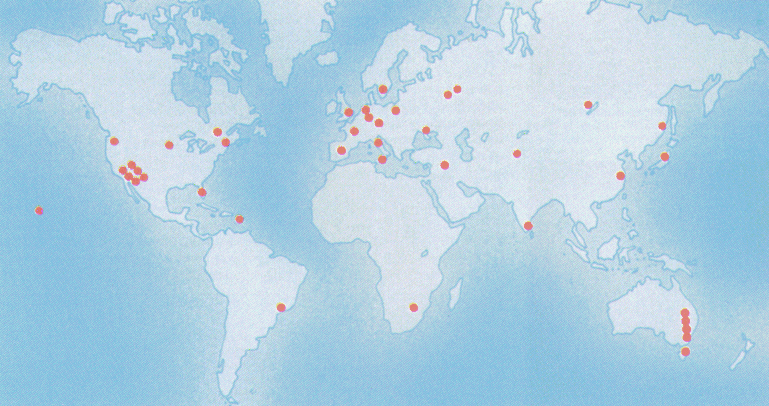 |
By combining data from telescopes around the world, we can get the resolution of a telescope as big as the earth! (From MERLIN VLBI page, http://www.jb.man.ac.uk/merlin/about/layman/vlbi.html) |
This technique is called very large baseline interferometry (VLBI).
The more telescopes, the better the picture from an interferometer- until we
get a filled mirror like a visible light telescope. The resolution will still go as ![]() /D
(where D is now the diameter of a telescope mirror), but the images will be better. When
radio astronomers want the best possible pictures like from a visible light telescope, they
need very large telescopes for good resolution (
/D
(where D is now the diameter of a telescope mirror), but the images will be better. When
radio astronomers want the best possible pictures like from a visible light telescope, they
need very large telescopes for good resolution (![]() is so large for them); the one below (at Greenbank W. Va.From
NRAO, NSF, http://antwrp.gsfc.nasa.gov/apod/ap020311.html)
is more than 300 feet in diameter.
is so large for them); the one below (at Greenbank W. Va.From
NRAO, NSF, http://antwrp.gsfc.nasa.gov/apod/ap020311.html)
is more than 300 feet in diameter. ![]() To
the right, the telescope has been placed in Washington D. C. to give an idea of
its size (thanks to Photoshop and Michael Garrett).
To
the right, the telescope has been placed in Washington D. C. to give an idea of
its size (thanks to Photoshop and Michael Garrett).
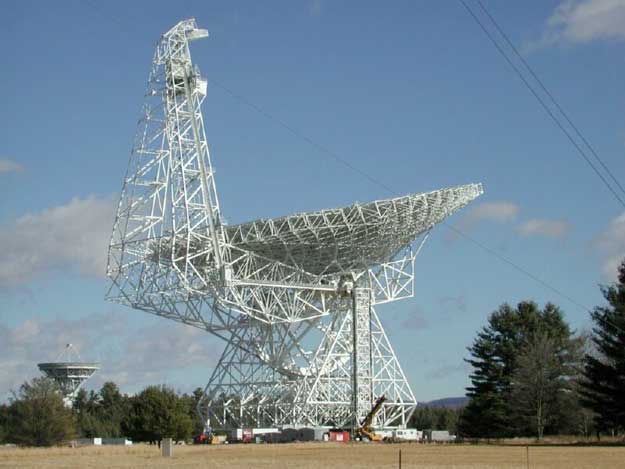 |
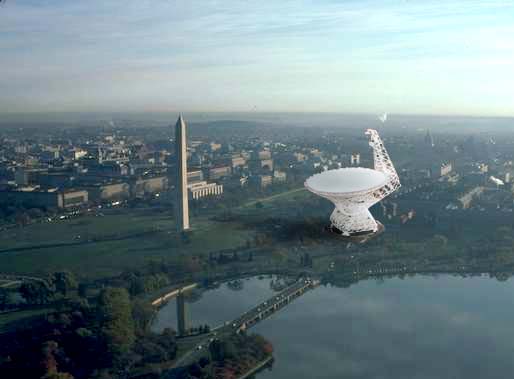 |
| Engineers, managers, and astronomers are working to build the next big space telescope, JWST - the James Webb Space Telescope (named after an early NASA Administrator). This picture is a full-scale model. The real thing is scheduled for launch in 2018. |
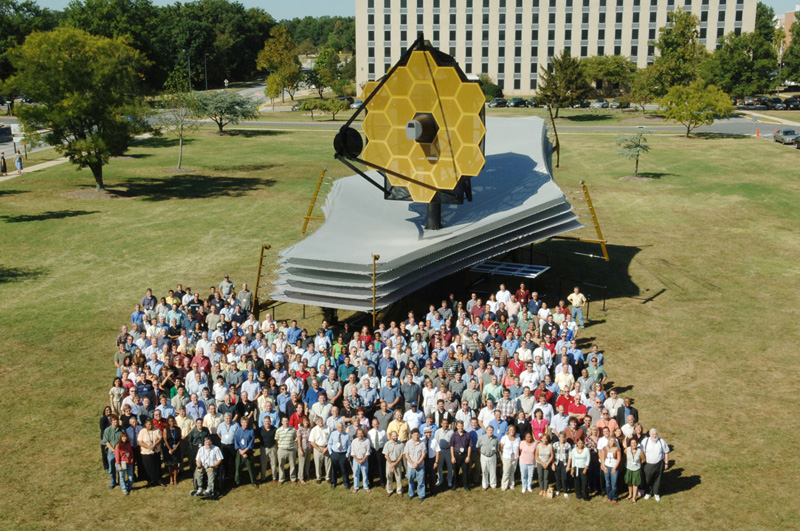 |